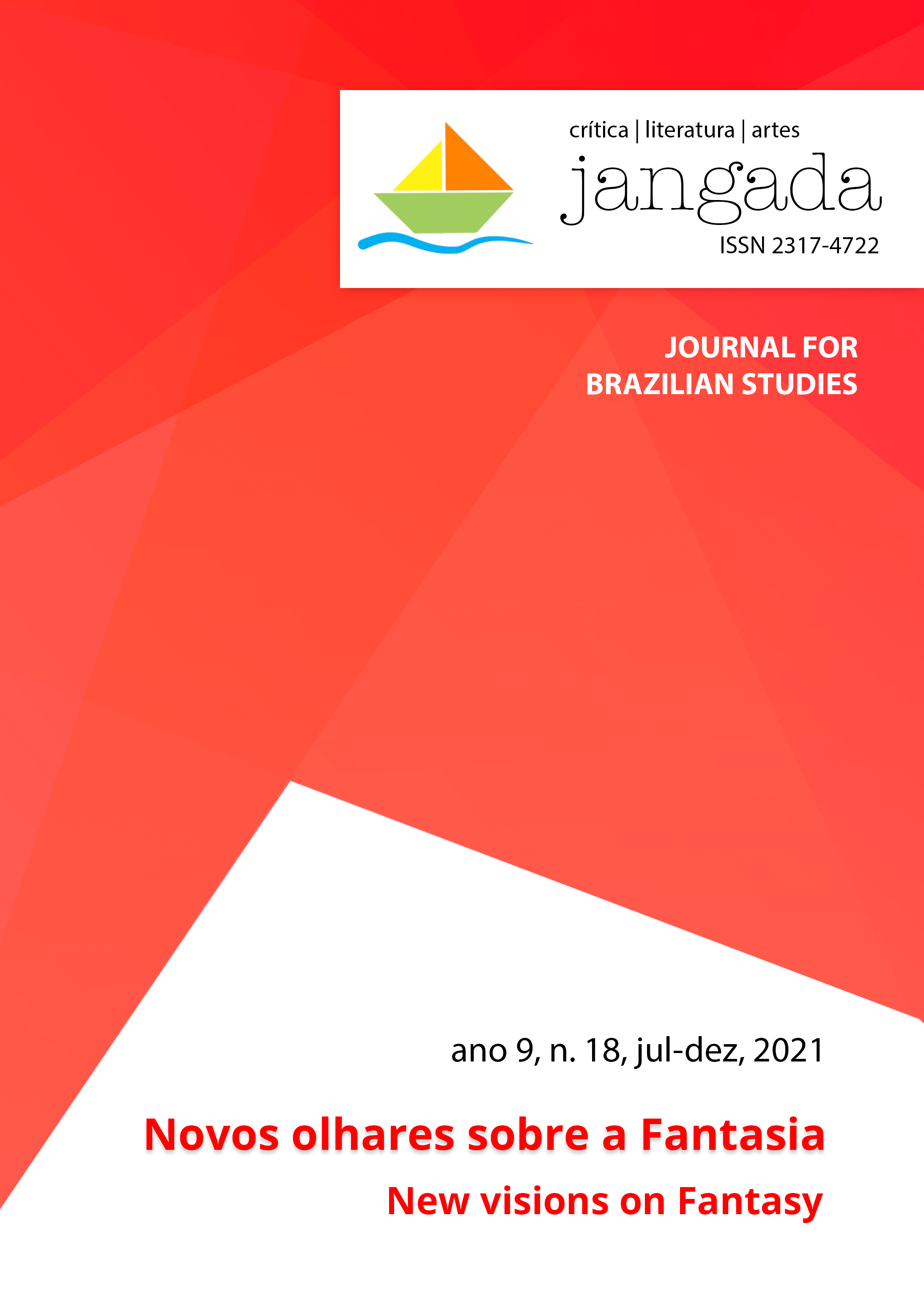Ch-ch-ch-changes: David Bowie’s generic influence on Jim Henson’s "Labyrinth" film franchise
DOI:
https://doi.org/10.35921/jangada.v1i18.426Keywords:
Urban Fantasy, speculative fiction, setting, Labyrinth, Jim Henson, David Bowie, genreAbstract
Jim Henson’s Labyrinth has been a family staple for almost forty years. Steadfast in its popularity, the film was even lauded as a cult-classic for the 30th anniversary re-release. Though this newfound status has done little to alleviate the persistent difficulty of generic categorisation, instead it highlights Labyrinth’s awkwardness when grouped among contemporaneous fantasy or adventure films. Henson had originally intended to make a traditional secondary-world fantasy, yet during production the film would undergo a host of unexpected changes, many of which came about after casting David Bowie as the film’s antagonist. The latter alterations led Labyrinth down a winding and transformative path, rendering the magical movie both more mature and generically anomalous for its time. Yet, when the film’s trans-mediatic elements are also taken into consideration, it appears to parallel another genre in the fantastic mode that rose to popularity in print at the same period: Urban Fantasy. Leaning on recent research of both the latter and its better-known cousin, Fantasy, the following article considers Bowie’s influence on the production of Henson’s Labyrinth, as well as on its story, score, and setting.
Downloads
References
BIBLIOGRAPHY
ATTEBERY, B. Strategies of Fantasy. Bloomington & Indianapolis: Indiana University Press, 1991.
BOWIE, D. Chilly Down. New York: EMI, 1986. (a)
BOWIE, D. Underground. London: EMI, 1986. (b)
BOWIE, D. Magic Dance. New York: EMI, 1987.
BUDIANSKY, B. Labyrinth. v. 1. New York: Marvel, 1986.
BULL, E. War for the Oaks. Orb 2001 ed. New York: Ace, 1987.
BUTCHER, J. The Dresden Files series. New York: Roc Books, 2000.
CLUTE, J.; LANGFORD, D. Urban Fantasy (J. Clute, J. Grant, Eds.) The Encyclopedia of Fantasy. London: Orbit, 1997. Available at: <http://sf-encyclopedia.uk/fe.php?nm=urban_fantasy>. Accessed: 15 Aug. 2019.
DE LINT, C. Moonheart. Orb 1994 ed. New York: Ace, 1984.
DEROCHEA, B. Brian Froud, Wendy Froud & Terri Windling: making faeries. Rambles.net, 9 Jan. 2000. Available at: <http://www.rambles.net/froud_windling.html>. Accessed: 20 Jun. 221.
EKMAN, S. Urban Fantasy: A Literature of the Unseen. Journal of the Fantastic in the Arts, v. 27, n. 3, p. 452–469, 2016.
FORBES, J. T. Jim Henson’s Return to Labyrinth. v. 1. Los Angeles: Tokyopop, 2006.
FRITH, S.; STRAW, W.; STREET, J. (ed.). Star Profiles II. In: The Cambridge Companion to Pop and Rock. Cambridge: Cambridge University Press, 2001. p. 193–210.
FROUD, B.; FLETCHER, R. 9 gorgeous Labyrinth secrets – told to us by the man who made it. Disponible at: <https://www.digitalspy.com/movies/a811304/gorgeous-secrets-from-labyrinth-from-the-man-who-made-it/>. Accessed: 17 Jun. 2021.
GOETHE, J. W. V. The Erl-King. In: The Poems of Goethe. Translation, Edgard Alfred Bowring. London: Parker and Son, 1853.
Labyrinth (1986) - IMDb. Available at: <https://www.imdb.com/title/-tt0091369/?ref_=adv_li_tt>. Accessed: 20, Jun., 2021.
HENSON.COM. ‘4/8-10/1985 – ‘Work with Elaine May on script.’ Available at: <https://www.henson.com/jimsredbook/2012/04/48-101985/>. Accessed: 12, Jun. 2021.
HENSON, J.; OZ, F. The Dark Crystal. Universal Pictures, 13 Dec. 1982.
HENSON, J.; PIRANI, A. Into the Labyrinth with Jim Henson: Part Two. Starlog: The Science-Fiction Universe, n. 109, 1986. Available at: <https://archive.org/details/starlog_magazine-107>.
HENSON, J.; SCHLOCKOFF, A. Jim Henson: “le labryinthe est un voyage à travers une réalité aussi déconcertante que la vie même”. L’écran fantastique, n. 77, p. 36–39, Feb. 1987.
MCLENNON, L. Defining Urban Fantasy and Paranormal Romance: Crossing Boundaries of Genre, Media, Self and Other in New Supernatural Worlds. Refractory: A Journal of Entertainment Media 23, 2014. Available at: <https://refractory-journal.com/uf-mclennon/>.
MENDLESOHN, F.; JAMES, E. A Short History of Fantasy. 2nd. ed. Oxfordshire: Libri Publishing, 2012.
MENDLESOHN, F. Rhetorics of Fantasy. Connecticut: Wesleyan University Press, 2008.
MIÉVILLE, C. Perdido Street Station. New York: Del Rey, 2000.
PHILIPS, L.; JONES, T. Labyrinth. Available at: <http://www.astrolog.org/labyrnth/script.txt>. Accessed 15 Jun. 2021.
RIDLEY SCOTT. Legend. 20th Century Fox, 1985.
SAUNDERS, D. Inside the Labyrinth Jim Henson Television, 1987.
SMITH, A. C. H. Labyrinth: a Novel. New York: Henry Holt and Company, 1986.
TODOROV, T. Introduction à la littérature fantastique. Paris: Editions du Seuil, 1970.
WILLIAMS, O. Labyrinth: the behind-the-scenes history. Empire Magazine, n. 272, feb. 2012. Available at: <https://www.empireonline.com/movies/features/labyrinth-movie-history/>. Accessed: 14 Jun. 2021.
WINDLING, T. Artist of the Week - Terri Windling. Modern Fairies, 19 Nov. 2018. Available at: <http://www.modernfairies.co.uk/blog/artist-of-the-week-terri-windling>.
------------------- Introduction. In: BLACK, H.; KUSHNER, E. (Ed.). Welcome to Bordertown: New Stories and Poems of the Borderlands. New York: Random House, 2011. p. 4–8.
WYNNE JONES, D. The Tough Guide to Fantasy Land. London: Gollancz, 1996.








